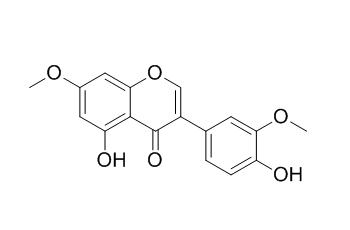7,3'-Di-O-methylorobol
7,3'-Di-O-methylorobol is a natural product from Sophora japonica L.
Inquire / Order:
manager@chemfaces.com
Technical Inquiries:
service@chemfaces.com
Tel:
+86-27-84237783
Fax:
+86-27-84254680
Address:
1 Building, No. 83, CheCheng Rd., Wuhan Economic and Technological Development Zone, Wuhan, Hubei 430056, PRC
Providing storage is as stated on the product vial and the vial is kept tightly sealed, the product can be stored for up to
24 months(2-8C).
Wherever possible, you should prepare and use solutions on the same day. However, if you need to make up stock solutions in advance, we recommend that you store the solution as aliquots in tightly sealed vials at -20C. Generally, these will be useable for up to two weeks. Before use, and prior to opening the vial we recommend that you allow your product to equilibrate to room temperature for at least 1 hour.
Need more advice on solubility, usage and handling? Please email to: service@chemfaces.com
The packaging of the product may have turned upside down during transportation, resulting in the natural compounds adhering to the neck or cap of the vial. take the vial out of its packaging and gently shake to let the compounds fall to the bottom of the vial. for liquid products, centrifuge at 200-500 RPM to gather the liquid at the bottom of the vial. try to avoid loss or contamination during handling.
Front Microbiol.2023, 14:921653.
J Cell Physiol.2020, 10.1002
J Separation Science & Technology2016, 51:1579-1588
Integr Med Res.2024, 13(1):101025.
Comp. & Mathematical Methods in Med.2022, 5475559.
J Sep Sci.2018, 41(7):1682-1690
J.Acta Agriculturae Scandinavica2017, 571-575
Evid Based Complement Alternat Med.2021, 2021:8707280.
J Biomed Sci.2020, 27(1):60.
Molecules.2021, 26(13):4081.
Related and Featured Products
Molecules. 2012 Jul 3;17(7):7989-8000.
Flavonoids and other compounds from Ouratea ferruginea (Ochnaceae) as anticancer and chemopreventive agents.[Pubmed:
22759912 ]
METHODS AND RESULTS:
The chemical study of the extracts from leaves and stems of Ouratea ferruginea allowed the identification of a new isoflavone, 5-hydroxy-7,3'4'5'-tetramethoxyisoflavone, and twenty two known compounds, including friedelin, 3β-friedelinol, lupeone, a mixture of sitosterol, stigmasterol and campesterol, sitosteryl- and stigmasteryl-3-O-b-D-glucopyranosides, 5,4'-dihydroxy-7,5',3'-trimethoxyisoflavone, 5,4'-dihydroxy-7,3'-di-methoxyisoflavone (7,3'-Di-O-methylorobol), 5,7,4'-trihydroxy-3',5'-dimethoxyisoflavone (piscigenin), 2R,3R-epicatechin, syringic acid, 2,6-dimethoxybenzoquinone, 2,6-dimethoxyhydroquinone, syringic and ferulic aldehyde, a mixture of vanillic acid, 1-hydroxy-2-methoxy-4-(1E-3-hydroxy-1-propenyl)-benzene and 3,5-dimethoxy-4-hydroxy-dihydrocinamaldehyde, besides amenthoflavone and 7-O-methylamenthoflavone (sequoiaflavone) which are considered as chemotaxonomic markers of Ouratea. The structures were identified by IR, (1)H- and (13)C-NMR and GC-MS, HPLC-MS, besides comparison with literature data. The inhibitory effects of 5,4'-dihydroxy-7,5',3'-trimethoxyisoflavone, 7,3'-Di-O-methylorobol, piscigenin and 7-O-methylamenthoflavone on cytochrome P450-dependent 7-ethoxycoumarin O-deethylase (ECOD) and glutathione S-transferase (GST) were evaluated in vitro.
CONCLUSIONS:
The 5,4'-dihydroxy-7,5',3'-trimethoxy-isoflavone was the best inhibitor, inhibiting almost 75% of GST activity. Sequoiaflavone was the most potent inhibitor, inhibiting ECOD assay in 75%. These activities allow us to consider both these flavonoids as potential anticancer and chemopreventive agents.
J Asian Nat Prod Res. 2002 Mar;4(1):1-5.
A new coumaronochromone from Sophora japonica.[Pubmed:
11991186 ]
METHODS AND RESULTS:
A new coumaronochromone derivative, sophorophenolone (1), along with 13 known compounds, l-maackiain (2), medicagol (3), 7-O-methylpseudobaptigenin (4), pseudobaptigenin (5), 7,3'-Di-O-methylorobol (6), genistein (7), prunetin (8), daidzein (9), formononetin (10), Di-O-methyldaidzein (11), quercetin (12), kaempferol (13) and isorhamnetin (14) were isolated from pericarps of Sophorajaponica L.
CONCLUSIONS:
The structure of compound 1 was established by UV, IR, MS, and one-dimensional and two-dimensional NMR spectroscopy, including DEPT, NOESY, 1H-1H COSY, HMQC, and HMBC experiments.



